Why reducing EMF can help diabetes

Did you know that Thomas Edison and Alexander Graham Bell were both diagnosed with diabetes after conducting electrical experiments?
John Rollo wrote the first book on diabetes in 1798 and had only seen three cases himself in the twenty-three years he practiced medicine.
In 1876, many practitioners such as Benjamin Richardson considered diabetes to be “a modern disease caused by exhaustion from mental overwork or by some shock to the nervous system. Yet it was still uncommon.” 1
How did diabetes come to be one of society’s greatest killers?
Before we can ask if EMFs cause diabetes, let's learn from history.
What is Type 3 Diabetes?
There are three types of diabetes:
Type 1 - genetic, occurs mostly in children, accounts for 5% of cases
Type 2 - epigenetic - due to lifestyle, adult-onset, accounts for 90-95% of cases
Type 3 - epigenetic - environmental triggers like EMF cause blood sugar to spike.2
We’ll be focusing on Type 3 in this article.
Sugar is only one of the culprits and fails to explain why diabetes is becoming increasingly prevalent.
Even after sugar consumption did not rise at all between 1922-1984, rates of diabetes skyrocketed tenfold.3

The American Indians have been called “genetically predisposed” to diabetes. We’re told that this predisposition is triggered by a sedentary lifestyle of living on the reservation, compounded by the fact that they eat fry bread made with white flour and sugar.
However, Indians have been eating fry bread as a staple since the 1800s, and diabetes did not exist among them until 1950.
What changed?
In 1950, the first electric service came to Standing Rock in the Dakotas, along with others including the Gila River Reservation, whose inhabitants were revealed in a study conducted by the US Indian Health Service to have 380 cases of diabetes per 1000.4

Bhutan, an isolated community in the Himalayas that abides by its traditional culture and ancestral foods to this day, serves as another salient example.
Bhutan had some of the healthiest people in the world, with little disease.
There was no electrification in most of the country, until 2002, when the Bhutan Power Corporation was launched. In 2004, 634 new cases of diabetes were reported in Bhutan. In 2007 there were 2,541 cases with 15 deaths.5
The rise in mortality and illness was even blamed on the Bhutanese diet, one that they had followed for thousands of years.
Is obesity a symptom of diabetes?
Before the 1900s, diabetics were also not overweight. Today, most are overweight due to their cells’ reduced ability to metabolize fats. Impairment of fat metabolism is a sign that the engines of our cells, the mitochondria, aren’t working efficiently.
Mitochondrial metabolism is disrupted by radiowaves and Wi-Fi. This occurs because EMFs reduce the ability for our bodies to use free electrons to power the basis of our metabolism - the electron transport chain (ECT). Our ECT requires certain enzymes in order to efficiently generate energy for our bodies. Think of our ECT as a slow-burning campfire, which uses infrared and full spectrum Sunlight to create energy.
What happens when we introduce electrosmog? Our metabolic campfire dies out from too much electric rain. Now our mitochondria are stuck in the middle of the woods with no flashlight - because we’re only using the light of our iPhones to guide us back into a black phone forest of no return.
Wireless radiation dampens the enzyme activity of cytochrome C oxidase, and our cells cannot breakdown or metabolize food efficiently.
In 2010, Harvard, along with the University of Massachusetts and Joslin Diabetes Center, published a review of the role of mitochondria in diabetes, and concluded that there was a “failure of mitochondria to adapt to higher cellular demands.”
Does EMF cause diabetes?
During the Cold War, the Joint Publications Research Service translated foreign documents of Soviet research, which showed how participants exposed to electromagnetic fields similar to those of the cordless phones and cell phones we have today were prediabetic and had sugar in their urine after the experiments.6
In 2011, Finnish researchers conducted brain scans and submitted their findings to the Journal of Cerebral Blood Flow and Metabolism, showing that glucose metabolism is disrupted in the region of the brain next to a cell phone.
In 1997, diabetes cases soared 31% in one year. This is the same year that cell phones were no longer a luxury and became a commonplace necessity.
Before 1997, rural areas of the US did not have cell towers.

A case study on diabetes and EMF:
In this study, Dr. Magda Havas examines four different individuals, each with varying types of diabetes. When the study participants are able to reduce their EMF exposure, their blood sugar levels drop:
Why diabetics need UV light
Did you know that diabetics often have low Vitamin D levels?8
A healthy kidney is loaded with vitamin D receptors, which convert D to calcitriol, which then helps our bodies regulate calcium levels.
Why aren’t doctors prescribing Sunlight, rather than dialysis, for diabetics?
You may also notice that many diabetics have teeth that are more yellow than translucent white. Dentin is a layer of material that lies immediately underneath the enamel of our tooth, and is loaded with calcium. Doctors like Jack Kruse are finding that many diabetics have defects in POMC (proopiomelanocortin) in their dentin and other tissues, causing this yellow color.
How do we ensure we have optimal amounts of POMC?
By exposing ourselves to full spectrum UV light!
POMC also helps us make melanocyte-stimulating hormone (MSH). Both hormones help us control appetite by balancing our levels of leptin.
POMC needs sunlight and the right amount of thyroid stimulating hormone (TSH) to work efficiently. Ultimately, POMC helps us maintain blood sugar levels, protects the body from stress, and suppresses inflammation. POMC is a critical regulator of energy balance. Much of what is known about our brain’s control of overall energy balance and fat storage stem from what we know about the melanocortin system and leptin.
In the course of chronic kidney disease, alterations in vitamin D metabolism contribute to increases in the levels of parathyroid hormone.
Why is this a problem? Hyperparathyroidism can create too much calcium in our bodies, leading to a host of chronic diseases - including brain fog and fatigue.
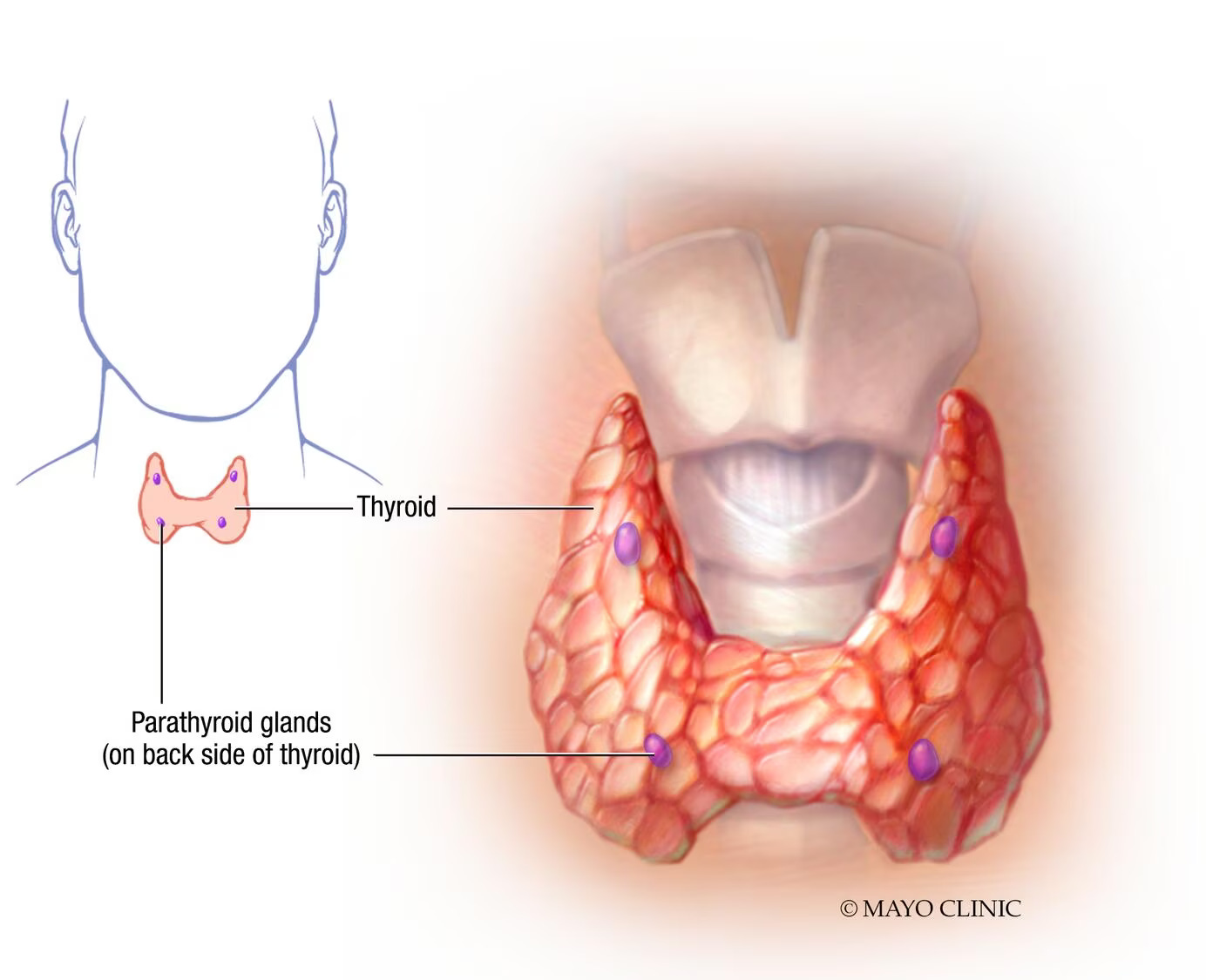
If you’ve followed the work of Dr. Martin Pall, you’ll know that wireless radiation can effect how our bodies process and use calcium. An Eastern perspective of how EMFs impact us maintains that it’s not calcium, but our very life force, our élan vital, that is affected. According to traditional Chinese medicine, our kidneys are the source of qi, or vital life force energy. It seems that both east and west can agree that we don’t need EMF giving us cheap shots to our kidneys.
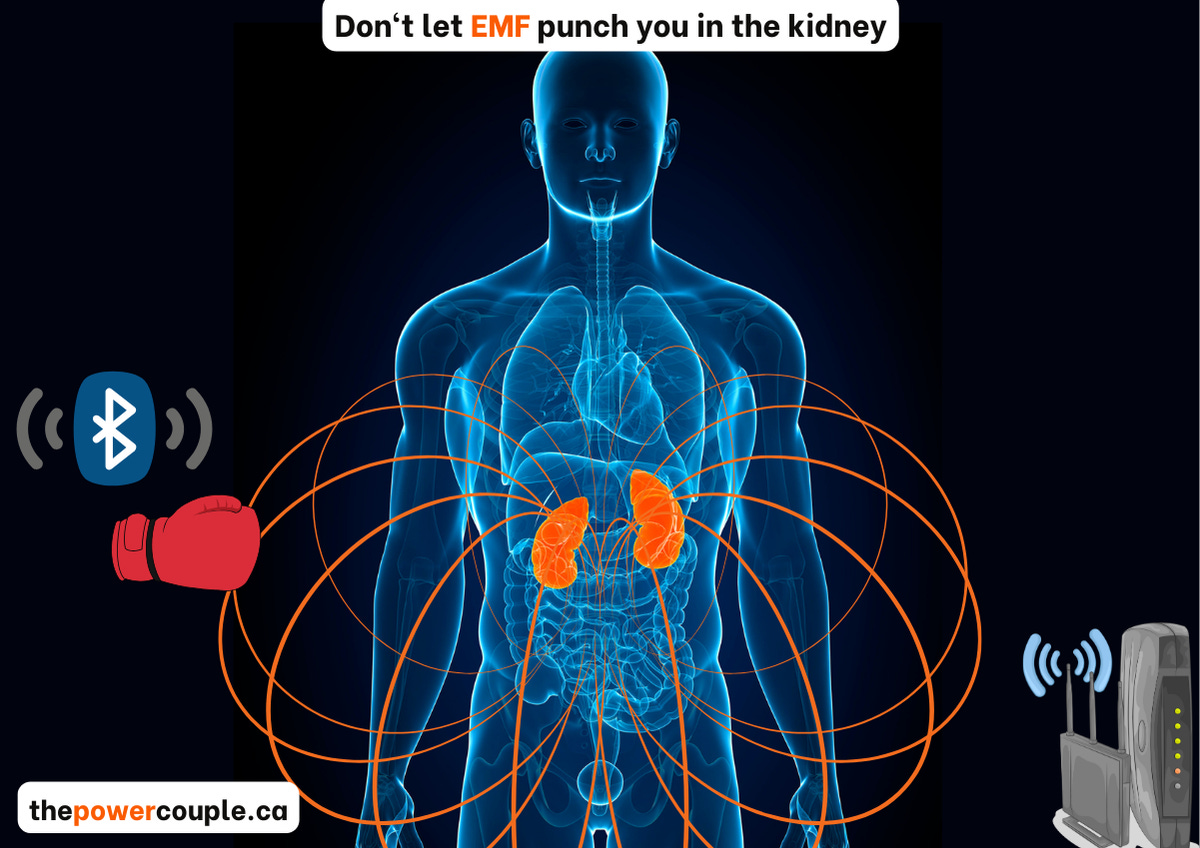
Protect your eyes from diabetes
In many diabetics, their macula (part of the retina at the back of the eye) also loses its yellow pigment Yellow pigments come from carotenoids like lutein and zeaxanthin (found in eggs and shrimp).
These pigments are yellow to preserve the sharp central vision of the macula and absorb any stray blue light as a complementary color. Blue light causes visual blur when your macula is damaged. Many diabetics have this blur before they get diagnosed. Blur occurs because blue light bends more than other wavelengths of color.
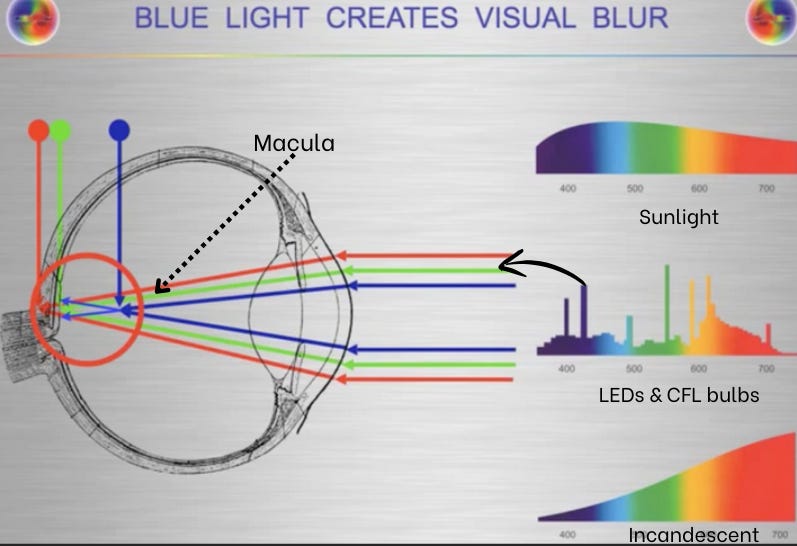
Diabetics also tend to show an altered pupillary response to blue LEDs.9 This would make sense if their melanopsin (blue-light detectors) are ruined by massive exposure to blue light - the #1 toxin of our time. Blue light also destroys the blood vessels in this middle region of the retina.
Here are more pathways by which blue light creates metabolic disorder:
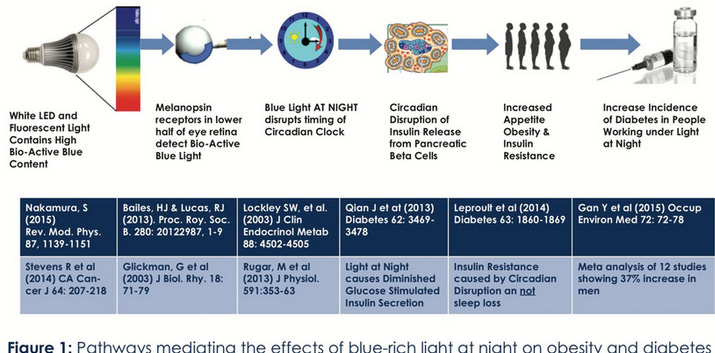
Furthermore, a 2022 study in the Journal of the Endocrine Society showed that a disrupted circadian rhythm can increase the risk of young-onset Type 2 diabetes in 14 year old boys.10
What are most teen boys exposed to at night, which also changes our normal circadian rhythm?
Blue light. Get out of its way, or start hanging out with Wilford Brimley.
Upgrade your metabolism with UV
Many hypothyroid (thyroid with low activity) diabetic patients have difficulty tanning because their skin is atrophic (pale with lesions) due to a lack of melanocyte-stimulating hormone (MSH).
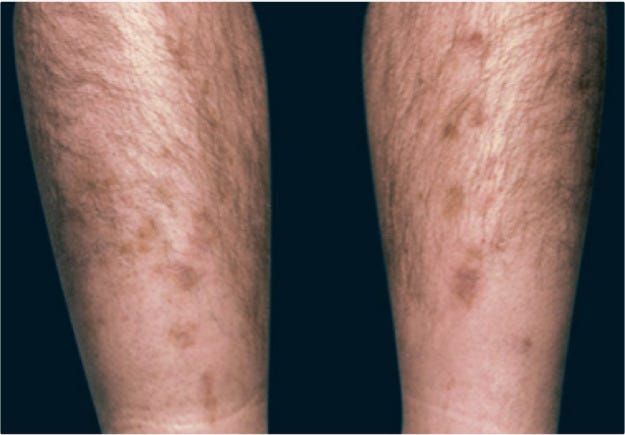
We make MSH by exposing ourselves to UV light. Judging by the amount of people sheltering indoors with their iPads, and avoiding the Sun, we can expect diabetes to soar, especially in younger populations.
Why else is UV good for a diabetic?
Regular exposure to solar UV light via our eyes and skin stimulates our thyroid and brain to make the T3 thyroid hormone. T3 balances our body's metabolism. Tanning in full spectrum Sunlight also increases our metabolism, which in turn helps us maintain a healthier weight.
Wild Fat Rats Can't Stop Eating Sugar too?
David B. Allison, Professor of Biostatistics at the University of Alabama School of Public Health, analyzed over 20,000 animals from twenty-four populations, and found that the average weight of the animals rose over time.
Chimps gained the most and were twenty-nine times more obese in 2005 compared to 1985. Even country rats were 15% more obese each decade, over a period of 40 years.
Wild and domestic animals had both been gaining weight since at least the 1940s.

Let’s stop playing in the electric monsoon of EMF, and dry ourselves off with a warm towel of light.
Only we can stoke our metabolic campfire.
No one is coming to save us, or the rats.
GET OUR MORNING POWER RHYTHM
Learn how to harness your LIFE FORCE, and activate the free medicine cabinet already within!

